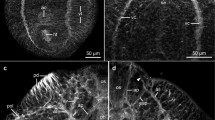Summary
In each ganglion of the nerve chain of Eisenia foetida there are several types of neurosecretory cells. They are constant in number and strictly localized. A. Toward the front of the ganglion, the array includes (a) a pair of small cells in the anterior region, and (b) a pair of voluminous elements close to the origin of nerve 2 of the ganglion. These two types of cells are characterized by the presence of secretory granules in the perikaryon and in the axon. B. Between the origins of nerves 2 and 3 of the ganglion, there are (c) a pair of cells possessing a large apical vacuole filled with a secretory material, and (d) a dozen cells distinguished by a dense, highly chromophilic cytoplasm. Only the cells of group (b) are present when the worm emerges from the cocoon. The cells of group (a) appear in the young worm. The cells of types (c) and (d) are only active in worms on their way to sexual maturity. The term “neurosecretory elements”, as applied to these different cell types is discussed.
Similar content being viewed by others
Bibliographie
Aros, B., and B. Vigh: Neurosecretory activity of the central and peripheral nervous system in the Earthworm. Acta biol. Acad. Sci. Hung. 12, 169–186 (1961).
—: Neurosecretion as a holocrine gland function in Lumbricidae. Acta biol. Acad. Sci. hung. 13 (2), 177–192 (1962).
Bern, H. A.: The secretory neuron as a doubly specialized cell. In: The general physiology of cell specialization, D. Mazia and A. Tyler, p. 349–366. New York: McGraw-Hill Book Co. 1963.
Brandenburg, J.: Neurosekretorische Zellen des Regenwurms. Naturwissenschaften 43, 453 (1956).
Deuse-Zimmermann, R.: Vergleichende Untersuchungen über Neurosekretion bei Enchytraeidae, Tubificidae und Naididae. Z. Zellforsch. 52, 801–816 (1960).
Herlant, M.: L'hypophyse et le système hypotalamo-hypophysaire du Pangolin (Manis tricuspis Ral. et Manis tetra dactyla L.). Arch. Anat. micr. Morph. exp. 47, 1–34 (1958).
Herlant-Meewis, H.: Neurosécrétion chez les Oligochètes. Bull. Acad. roy. Belg. Cl., Sci., 41 Ser. V, 500–508 (1955).
—: Croissance et neurosécrétion chez Eisenia foetida (Sav.). Ann. Sci. natur. Zool. 18, Ser. XI, 185–198 (1956).
—: Reproduction et Neurosécrétion chez Eisenia foetida (Sav.). Ann. Soc. roy. zool. Belg. 87 (1), 151–183 (1956–1957).
—: Evolution des caractères sexuels au cours de la croissance et de la reproduction chez Eisenia foetida. Ann. Soc. roy. zool. Belg. 89 (2), 281–336 (1958–1959).
—: Régénération du système nerveux chez Eisenia foetida (Sav.). Bull. biol. France et Belg. 95 (4), 695–730 (1961).
—: Influence de la nutrition sur la reproduction chez Eisenia foetida. C. R. Acad. Sci. (Paris) 255, 2187 (1962).
- Morphology of Invertebrates neurosecretory systems. Proc. of the 2d Internat. Congr. of Endocrinology, London 1964 (in press).
—: Regeneration in Annelids. In: Advances in Morphogenesis (M. Abercrombie et J. Brachet), vol. 4, p. 155–215. London and New York: Academic Press 1965.
— et N. van Damme: Phénomènes neurosécrétoires chez Nereis diversicolor et Eisenia foetida. C. R. Acad. Sci. (Paris) 255, 2291–2293 (1962a).
—: Neurosecretion and Wound-healing in Nereis diversicolor. Mem. Soc. Endocr. No 12, 287–295 (1962b).
-, P. van Gansen et J. Skala: Influence de milieux d'élevage expérimentaux sur la croissance et la sexualité du Lombricien Eisenia foetida Sav. Ann. Soc. roy. zool. Belg. 94 (2) (1965) (sous presse).
—, et J.-J. van Mol: Phénomènes neurosécrétoires chez Arion rufus et Arion subfuscus. C. R. Acad. Sci. (Paris) 249, 321 (1959).
Hubl, H.: Über die Beziehungen der Neurosekretion zum Regenerationsgeschehen bei Lumbriciden nebst Beschreibung eines neuartigen neurosekretorischen Zelltyps im Unterschlundganglion. Arch. Entwickl.-Mech. Org. 149, 73–87 (1956).
Michon, J., et Fr. Alaphilippe: Contribution à l'étude de la neurosécrétion chez les Lumbricidae. C. R. Acad. Sci. (Paris) 249, 835–837 (1959).
Nolte, A.: Ultrastruktur des „Neurosekretmantels“ des Nervus labialis medius von Planorbarius corneus L. (Basommatophora). Naturwissenschaften 51, 148 (1964).
Otremba, P.: Beobachtungen an neurosekretorischen Zellen des Regenwurmes (Lumbricus spec.). Z. Zellforsch. 54, 421–436 (1961).
Author information
Authors and Affiliations
Additional information
Dédié au Professeur W. Bargmann À l'occasion de son 60e anniversaire.
Rights and permissions
About this article
Cite this article
Herlant-Meewis, H. Les cellules neurosecretrices de la chaine nerveuse d'Eisenia foetida . Z.Zellforsch 69, 319–325 (1966). https://doi.org/10.1007/BF00406284
Received:
Issue Date:
DOI: https://doi.org/10.1007/BF00406284




